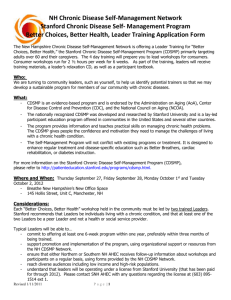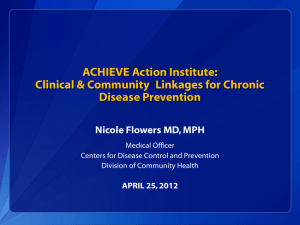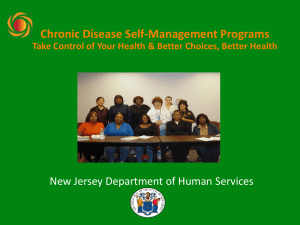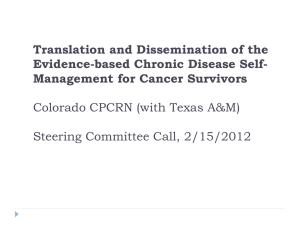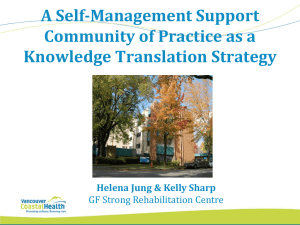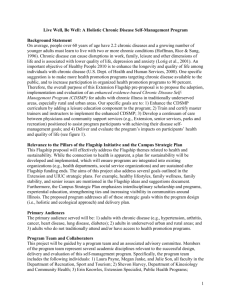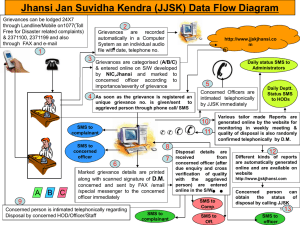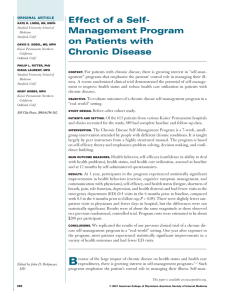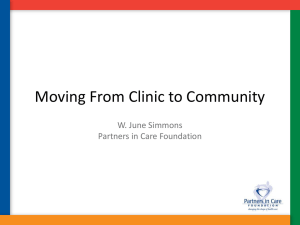Presentation - Self
advertisement
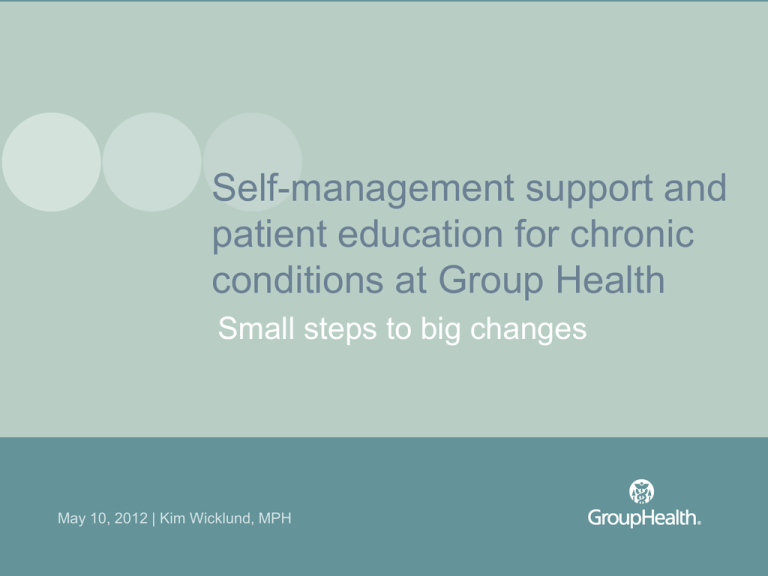
Self-management support and patient education for chronic conditions at Group Health Small steps to big changes May 10, 2012 | Kim Wicklund, MPH Randy’s story Whether you think you can do a thing or you can’t do a thing, you’re right. – Henry Ford Chronic Conditions in U.S. Among the American adult population: 50% have at least one chronic condition 25% have multiple chronic conditions 75% of people age ≥65 have multiple chronic conditions ½ of those with hypertension, and over 60% of those with diabetes and hyperlipidemia do not have conditions well controlled Vogeli, Shields, Lee 2007 JGIM Medical Panel Expenditure Survey 2006 Schneider et al. 2009 Bodenheimer, Wagner, Grumbach 2002 JAMA Chronic Care Model Rationale for self-management support Through SMS people gain knowledge, skills, and self-confidence Majority of care for chronic conditions is complex and challenging self care SMS improves patient outcomes and controls costs Various SMS approaches: care managers, one-onone, group, telephonic coaching, online, peer Need effective models that are affordable and have population level impact Chronic Disease Self-Management Program Developed at Stanford Patient Health Education Research Center 6-week workshop (2.5 hrs/wk) based on self-efficacy theory Designed for people with one or more chronic conditions Leaders have personal experience with chronic conditions Premise– people with chronic conditions share similar challenges and need to master a generic set of selfmanagement skills Contributes to improvements in psychological health status, self-efficacy and select health behaviors. Modest effects can have significance across large population. (CDC 5/2011) CDSMP at Group Health Started in 1998 18 medical centers 65 volunteer leaders Average age: 65 Most common conditions: diabetes, arthritis, asthma/COPD, heart disease, depression Reach 2009-2011: 1,615 Group Health patients Recruitment: letters, care team, ghc.org, flyers, word of mouth Challenges of scaling CDSMP Limited access for network members in eastern and central Washington Capacity determined by volunteer leader and room availability Schedule is sporadic Chronic condition flare-ups can impact attendance Difficult to commit to weekly 2 ½ hour sessions Discomfort discussing sensitive topics face to face Online CDSMP Online CDSMP pilot Funded by GHF Partners: NCOA, Stanford, GHRI Target: 500 participants Timeline: June, 2009-June, 2011 Eligibility: • Adult Group Health member • Any chronic condition • Enhanced access to MGH Intervention Follows structure of in-person program 6-week highly interactive online workshop 25 participants per workshop Two peer moderators New lessons posted each week Participants log on at their convenience 2-3 times/week Time commitment of 2-3 hours/week Home page Evaluation questions 1. Will the online program expand CDSMP’s reach to Group Health members who are not reached by the in-person workshops? 2. Will participants in the online program at Group Health experience similar benefits to those reported in Stanford’s evaluation? 3. What resources and expertise are needed to administer the online program at Group Health? 4. Is the online format a viable strategy for bringing the CDSMP intervention to scale at Group Health? Participant flow Stage in process Total Signed up as interested 1043 Enrolled 473 (45%) Attended ≥1 session 91% Completed ≥4 sessions 66% Data for baseline and 6 months 50% Evaluation Health Status Self-mgt behaviors Healthcare Utilization Self-efficacy • Social/role activity limitations • Exercise • Visits to physician 6 item selfefficacy scale • Communication w/MD • Visits to ED • Depression • Pain severity • Shortness of breath • Cognitive symptom management • Medication management • Self-rated general health • Smoking status • Health distress • Hospital stays • Nights in hospital Demographics Online (n= 478) Age: 18 – 39 40 – 64 >=65 Age range Mean age Gender Female Education High school or less College/Undergraduate Race White African American Asian/PI Marital status Single Married/domestic ptnr Separated/Divorced Widowed Health status Excellent/very good Good/fair Poor In-person (n= 1615) 13% 66% 21% 20 – 89 54 2% 32% 66% 17 – 96 68 83% 69% 18.3% 57.8% 86.7% 4.7% 4.4% 15.8% 66.6% 15.2% 2.4% 20.2% 72.6% 7.2% Conclusions 1. Online program expanded CDSMP’s reach 2. Benefits were similar to but not consistent with Stanford’s 3. Resources and expertise needed to administer the online program are reasonable Mixed staffing model– GH Administrator; NCOA mentor and facilitators Costs– per workshop: $4350; per participant: $174; per completer: $255 4. Online format is a viable strategy for helping to bring the CDSMP to scale at Group Health Other strategies Employer pilots Testing 3 approaches: 1. Worksite-based workshops (King County) 4 workshops- 56 employees Gold status for documented attendance of ≥4 sessions 2. Formal reporting of participation (SHWT) GH/SHWT reporting process for incentivizing employees attending ≥4 sessions online or in person 3. Employee self report on participation (Group Health) ≥4 sessions in person or online for 400 wellness points 317 reported met goal Disease-specific pilot Living Well with Diabetes (DSMP) GHF Partnership for Innovation grant to pilot 8-10 workshops To date offered 8 workshops to 128 people (14 scheduled) Evaluating impact on self-management behaviors, blood sugar knowledge, medication management “Today I received my latest blood and kidney test results, and for the first time in my adult life they all were within normal ranges. My A1c was 5.7….” Integrating referrals into care Point of care prompts in EMR CMEs and nursing education Clinical Pearls Standard tools Health Profile After Visit Summaries Brochures MyGroupHealth Reach 1999-2011 Online Total members enrolled in LWCC 1999 to 2011 (Online program implemented June 2009) Total In person 900 800 700 600 500 400 300 200 100 0 1999 2000 2001 2002 2003 2004 2005 2006 2007 2008 2009 2010 2011 Patient education resources Myths about patient education If patients have more information, they’ll have better outcomes. If I don’t share everything I know with my patients, they won’t fully understand their condition and what they need to do. If my patients hear medical jargon, that’s ok. They’ll be able to understand it from the context. My patient is well educated, so s/he will understand complex words and ideas. My patient didn’t ask any questions so s/he must have understood my instructions. The reality for many patients Most patients forget up to 80% of what their clinician tells them as soon as they leave the office Nearly 50% of what patients do remember they remember incorrectly Implications: – Non-adherence and disengagement – Patient safety concerns – Medication errors – Missed surgeries and other appointments Strategies for providing information Break the information into understandable chunks Use plain language Limit key points to 3 or fewer Focus on action-oriented messages Repeat key messages Use analogies to help explain concepts Use images and graphics Tailor the message to the patient Give consistent messages Modular approach Graphics clarify key concepts Action planning Action plan for diabetes management Patient instructions provided in AVS Lessons Learned Lessons learned We have an ethical obligation to provide effective SMS Patients want and need different options for engaging in SMS People cycle through readiness and need to hear about SMS from different sources at different times Clinical teams need ongoing reminders about the program Employers are an underutilized resource for promoting SMS Incorporating SMS concepts into patient education supports awareness of care team and patients about SMS Future directions Next steps Continue exploring how to integrate referrals into standard work Continue to identify alternative ways to reach network members Update functionality and design of online program Further analyze evaluation data Explore more partnerships with employers (SU, Puyallup Tribe) Partner with community programs to address gap areas Create online community of LWCC alumni to provide ongoing support Considering SMS program for youth or young adults Discussion
